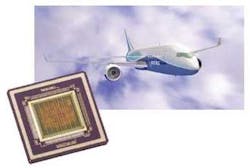Radiation threatens avionics as chip geometries shrink
By Ben Ames
SAN DIEGO — As they strive to fit more circuits onto each processor, chip makers shrink the die size in their fabrication plants. The trend runs throughout the integrated-circuit industry, from microprocessors and memory to field-programmable gate arrays (FPGAs) and application-specific integrated circuits (ASICs).
Yet this trend has a fatal flaw. Electronic components become vulnerable to neutron radiation as they use ever-smaller feature sizes and lower supply voltages, says John Fink, staff engineer at Honeywell Commercial Avionics Products in Minneapolis.
Naturally occurring radiation can corrupt memory through single-event upsets (SEUs), or even flood an entire component with excess current during a single-event latchup.
Although the implications are most dire for avionics, where a broken flight-control system could be deadly, they also affect ground-based systems such as banking, medical, and military devices, Fink said in an address last month at the Military & Aerospace Electronics Show in San Diego.
Fink is chairman of an industry group seeking solutions to this problem, Working Group #16 of the Aerospace Vehicle Systems Institute (AVSI).
Most chips today are made at 0.18 micron, a reference to the space between circuit wires. Some manufacturers use a 0.13-micron die, and have promised a 90-nanometer design for 2004. IBM leaders recently announced that their company would partner with chipmaker AMD in Sunnyvale, Calif., to build chips in a 65-nanometer form by 2005, and 45-nanometer by 2007.
Those complex chips generate a lot of heat, so engineers try to power them with less voltage. In recent years, the typical power supply has dropped from 5 volts to 3.3, 1.5, and soon 1.0.
Taken together, these two trends spell trouble for aircraft.
"The nanometer-scale semiconductor device challenge that the avionics industry faces today is as significant as the transition to solid state electronics 50 years ago," Fink says.
Already, 0.13 microns is small enough to cause problems on the ground, forcing office workers to reboot their PCs occasionally, he says. The problem is much worse for airplanes flying at 40,000 to 60,000 feet, since radiation gets more intense with altitude.
In one example, Honeywell's subcontractor for avionics memory began building equipment on a smaller die; the company did not inform Honeywell engineers because the devices still satisfied specifications for form, fit, and function, Fink says. Then pilots began to report in-flight memory failures, so Honeywell had to replace all the devices at great cost.
"There's more scary data on radiation failures for microprocessors than memory because they have large internal cache memories, which aren't amenable to error correction," Fink says. "And there's insufficient testing of complex ICs, which today can have 10 million gates on a chip."
Despite the danger, leaders of semiconductor companies are not inclined to research solutions, Fink says. They focus on their large customers in the data processing and telecommunications industries, instead of customers who demand small volume and stringent requirements.
For example, the U.S. National Aeronautics and Space Administration (NASA) often acquires enough components for the life of a short-term space program, simply by testing the first batch from a manufacturer. In contrast, a major commercial program could sustain demand for a new product for the next 20 or 40 years.
Likewise, manufacturers of consumer electronics build their products to last just two or three years, since cell phones and video games have gotten so cheap that users tend to throw out a broken one instead of repairing it.
Finally, planners at the U.S. Federal Aviation Administration (FAA) in Washington are not searching for answers because they are distracted by another electronics problem — obsolescence. The turnover of recent electronics design happens so quickly that FAA inspectors barely have time to inspect new components, much less add a new test for radiation protection.
Yet all segments of the avionics market are vulnerable, from general aviation (23 percent) to military (30 percent) and air transport (47 percent), Fink says.
Members of AVSI #16 try to unite researchers in industry, government, and academia. Members include: Boeing, Cessna, Goodrich, Honeywell, SAIC, Smiths Aerospace, and the U.S. Department of Defense. Dy4 Systems and Information Handling Systems are associate members. For more information, see the web site: avsi-tees.tamu.edu.
For a long-term solution, AVSI is cooperating with the European avionics community to develop a new standard, the Avionics Radiation Effects Specification (IEC TC 62396). Conference committees at the IEC and Government Electronics and Information Technology Association (GEIA) plan to release a draft in mid-2004.
In the near term, AVSI rents laboratory time in a neutron test facility at Los Alamos National Laboratory in Albuquerque, N.M. Working-group members can test their latest designs there to measure the effects of neutron radiation at airplane cruising altitude.
One of the first things researchers discovered is that shielding is no use. It takes several feet of lead to block neutron radiation, which is far too heavy to load on an aircraft. Even on the ground, it is hard to stop neutron radiation.
"The physicists at Los Alamos terminate their beam into a mountain, so that should tell you something," Fink says.

